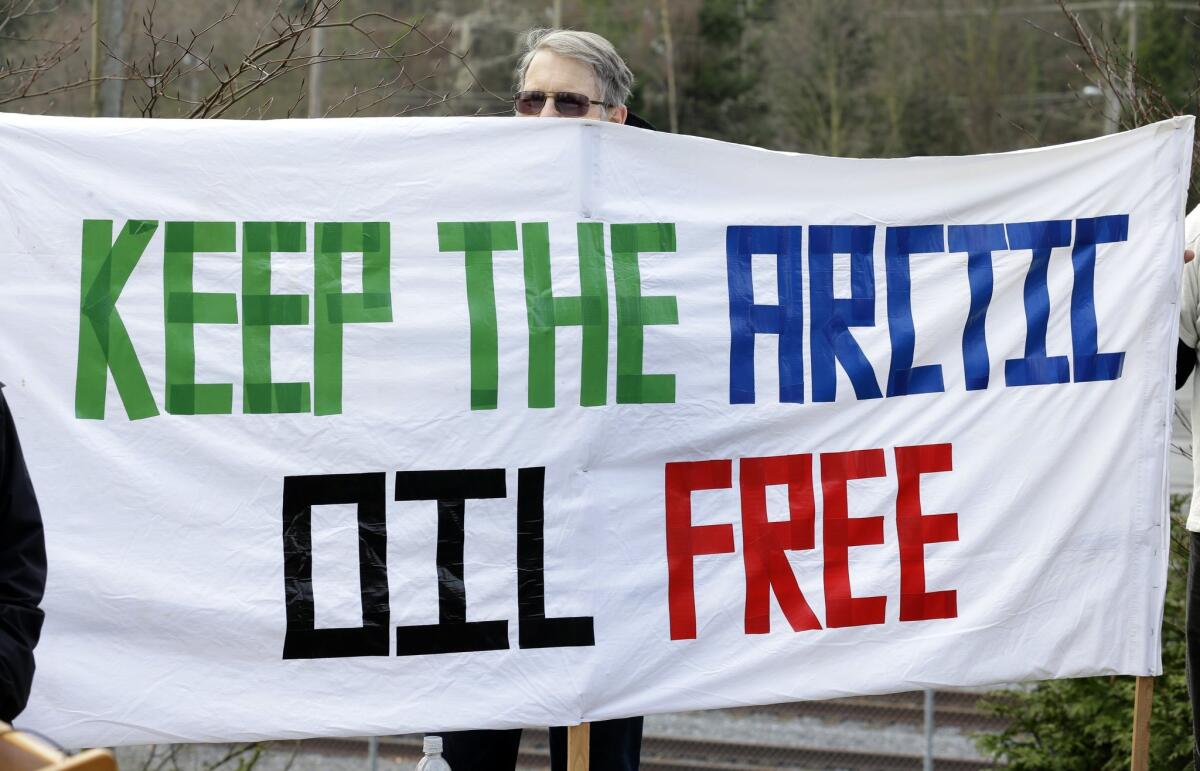Op-Ed: The Arctic’s big year - save it now or be sorry later

- Share via
This year will be pivotal for the Arctic, one of Earth’s most extraordinary and threatened regions.
The icy top of our planet is suffering effects of climate change more severely than elsewhere, with dramatic ecological and cultural consequences. Arctic sea ice has declined by about half in just 40 years, permafrost and the Greenland ice cap are rapidly melting, ecosystems are declining, and some coastal villages must move to higher ground.
But rather than intensifying efforts to protect the region, governments and industry are instead rushing to exploit the Arctic for oil and gas, minerals, shipping, fishing, tourism and military interests. Combined with climate change, such industrialization will further accelerate environmental decline.
Politicians pretend this development will help the people living in the Arctic, but in reality it is more about corporate profits and producing resources for economies to the south. This is a no-win race to Arctic destruction.
The situation with oil is particularly worrisome. Even after its calamitous failure in the Alaska Arctic in 2012 — with one drilling rig grounded, the other in disrepair and its drilling contractor pleading guilty to numerous safety and environmental violations — Shell Oil is planning to try again this summer. Other companies are drilling in Arctic waters off Greenland, Canada, Russia and Norway.
Despite industry and government assurances to the contrary, the extreme conditions of Arctic drilling all but guarantee oil spills and chronic degradation. And the billions of tons of carbon produced from the Arctic Ocean will ultimately wind up in the global atmosphere, further accelerating the climatic warming that is so disastrous for the Arctic.
In April, the U.S. will assume the chairmanship of the Arctic Council, the eight-nation intergovernmental forum established in 1998 to enhance cooperation among Arctic governments and peoples. The Obama administration has a historic opportunity to lead the international community to create a new Arctic paradigm, and protect this extraordinary place for all people and for all time. But first, the United States needs to lead by example.
The U.S. should be the first Arctic nation to “just say no” to more Arctic offshore oil. If the Obama administration is unwilling to do that (as seems likely), it at least must impose the highest possible safety standards for offshore drilling, which it has yet to do.
The U.S. should establish more rigorous Arctic shipping safety standards, including routing agreements, continuous tracking of ships, and rescue capabilities to minimize the risk of groundings and spills.
The president should use his executive authority to establish permanently protected marine national monuments in Alaska’s Aleutian Islands, the Bering Strait and the Arctic Ocean, and he should negotiate a sanctuary in international waters around the North Pole. Although the administration recently withdrew three areas in Alaska from possible offshore drilling, more protection over a greater area is urgently needed.
The U.S. must commit to deeper and faster cuts in our carbon emissions, and make good on that commitment.
It should then negotiate a comprehensive Arctic Treaty similar to the Antarctic Treaty, to protect and sustain the region as a common heritage of all humankind, with the greatest possible environmental protections across all Arctic waters and lands.
Finally, the U.S. needs to reach a legally binding deal in December at the United Nations Climate Change Conference in Paris to immediately and significantly reduce global carbon emissions. This would slow, and perhaps someday reverse, the melt of Arctic ice.
Society has a historic choice to make with the Arctic. Should we continue our industrial expansion into one of the last wild areas of the world, further degrading the environment of the region? Or should we choose to protect and sustain this magnificent place? We can’t have both.
Our choices in 2015 will tell us a lot about what the Arctic’s long-term future will be. Let’s hope we choose wisely.
Richard Steiner is a marine conservation biologist with Oasis Earth in Anchorage, Alaska. He was a professor at the University of Alaska from 1980 to 2010. He is presenting “Imperiled Arctic” to audiences this year.
Follow the Opinion section on Twitter @latimesopinion and Facebook
More to Read
A cure for the common opinion
Get thought-provoking perspectives with our weekly newsletter.
You may occasionally receive promotional content from the Los Angeles Times.






